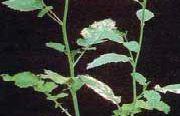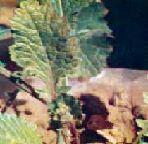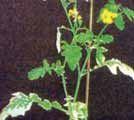Nutritional Deficiencies/Disorders of Mustard
Nutritional Deficiencies/Disorders of Mustard
Iron
 Chlorosis starts from the base and spreads towards the apical part of the lamina. In case of severe deficiency, leaves become bleached and puckered. Newly emerging leaves are completely bleached, those subtending these also develop pigmentation. Flowering, pod number and size of pods is reduced and pods appear chlorotic.
Chlorosis starts from the base and spreads towards the apical part of the lamina. In case of severe deficiency, leaves become bleached and puckered. Newly emerging leaves are completely bleached, those subtending these also develop pigmentation. Flowering, pod number and size of pods is reduced and pods appear chlorotic.
Correction measure: Spray 0.5% ferrous sulphate solution 3-4 times at weekly intervals.
Manganese
 Chlorosis in apical part of the middle leaves, followed by developing small greyish-brown spots which coalesce to form large necrotic lesions, Leaf margins also turn necrotic and the lamina curl downwards. Later, these symptoms spread to old and young leaves. Flowering is also reduced and large percentage of flowers shed prematurely, resulting in poor fruit set and pod formation.
Chlorosis in apical part of the middle leaves, followed by developing small greyish-brown spots which coalesce to form large necrotic lesions, Leaf margins also turn necrotic and the lamina curl downwards. Later, these symptoms spread to old and young leaves. Flowering is also reduced and large percentage of flowers shed prematurely, resulting in poor fruit set and pod formation.
Correction measure: Spray 0.2-0.3 % manganese sulphate 2-3 times at weekly intervals.
Copper
 Young leaves develop interveinal chlorosis. Chlorotic areas later turn papery and necrotic. Growth of plants is also reduced which is more pronounced at the time of flowering and thereafter. Inflorescence is very poorly developed and large percentages of the floral buds of the plants wither before opening. Pod formation and seed setting are also reduced.
Young leaves develop interveinal chlorosis. Chlorotic areas later turn papery and necrotic. Growth of plants is also reduced which is more pronounced at the time of flowering and thereafter. Inflorescence is very poorly developed and large percentages of the floral buds of the plants wither before opening. Pod formation and seed setting are also reduced.
Correction measure: Spray 0.2% copper sulphate solution 2-3 times at weekly intervals.
Zinc
 There is retardation of growth, deficiency symptoms appear after 20 days of sowing, the first true leaf is also affected. Leaves are small in size with pinkish margin. Interveinal tissues turn yellowish white to papery white, with veins remaining green. There is upward or downward cupping of leaves. Severely affected leaves die. Flowering and fruiting is delayed.
There is retardation of growth, deficiency symptoms appear after 20 days of sowing, the first true leaf is also affected. Leaves are small in size with pinkish margin. Interveinal tissues turn yellowish white to papery white, with veins remaining green. There is upward or downward cupping of leaves. Severely affected leaves die. Flowering and fruiting is delayed.
Correction measure: Application of 8-10 Kg/acre at sowing time of zinc sulphate overcomes zinc deficiency. Zinc sulphate should be placed in the seed row adjacent to the seed at the time of sowing to attain its higher utilization efficiency. Zinc deficiency can also be corrected by foliar spray of 0.5 per cent zinc sulphate solution along with 0.25 per cent slaked lime.
Sulphur
 Deficiency symptoms are shown on younger leaves. Chlorosis formation from leaf margins, spreading inward and/or develop purple pigmentation. Inward curling of young leaf lamina giving these leaves a cupped appearance followed by scorching and withering. Flowering is delayed, lacking normal pigmentation. Pods are borne on short peduncle and their development is restricted. Seed setting is poor and their maturity is delayed. Sulphur deficient plants show marked retardation in height, thickness of stem and size of leaves.
Deficiency symptoms are shown on younger leaves. Chlorosis formation from leaf margins, spreading inward and/or develop purple pigmentation. Inward curling of young leaf lamina giving these leaves a cupped appearance followed by scorching and withering. Flowering is delayed, lacking normal pigmentation. Pods are borne on short peduncle and their development is restricted. Seed setting is poor and their maturity is delayed. Sulphur deficient plants show marked retardation in height, thickness of stem and size of leaves.
Correction measure: Apply gypsum@ 100 Kg/acre in soil. Use Sulphur containing fertilizers
Molybdenum
 Mustard is very susceptible to molybdenum deficiency. Growth is markedly reduced and plants develop foliar symptoms like cupping, marginal scorching and loss of lamina.
Mustard is very susceptible to molybdenum deficiency. Growth is markedly reduced and plants develop foliar symptoms like cupping, marginal scorching and loss of lamina.
Correction measure: Use Sodium molybdate 37 - 39%
IPM for Mustard
To know the IPM practices for Mustard, click here.
Source: NIPHM and Directorate of Plant Protection, Quarantine & Storage
Last Modified : 12/11/2019
This topic covers the information related to Nutri...
This topic provides information about Nutrient Def...
This topic covers information about Cabbage and Ca...
This topic covers the information related to Nutri...
